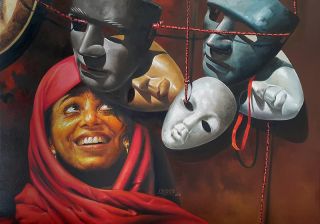Identity
Enacted Identities: Multiplicity, Plurality, and Tulpamancy
The neurodiversity of how we experience our socioculturally-constructed selves.
Posted February 13, 2023 Reviewed by Davia Sills
Key points
- Multiplicity, plurality, and tulpamancy bring a newfound awareness to the fact that many people experience a non-unitary self.
- Unlike dissociative identity disorder, these plural experiences are often not distressing or functionally impairing.
- Plurality may be better characterized and understood in terms of neurodiversity and Mad Studies.

Multiplicity and Plurality
In my previous blog post, I described how the "multiple personalities" and "dissociative identities" of dissociative identity disorder (DID) can be understood as "enactments" within both "sociocognitive" and "trauma" models where they're loosely defined as creations of identity with variable levels of volition or conscious intent. I also discussed how much of the debate about whether DID is "real" isn't so much a debate about whether DID really "exists," but rather what causes it and how it's best conceptualized (and, by implication, how it's best treated). In this blog post, I'll explore how a growing recognition of other "multiplicity" experiences is paving the way to a better understanding of DID and the broader spectrum of how we experience identity.
In 2015, a VICE article headline posed the provocative question, "Are multiple personalities always a disorder?" and went on to describe the seemingly novel phenomenon of individuals who experience multiple identities within an "multiplicity system." 1 Like the "alters" in DID, the "system members" within multiplicity systems "switch" and take turns "fronting," or interacting, with the outside world. But unlike those with DID, many who experience an internal life within a multiplicity system are fully aware of the existence of other members (and therefore use "we" as a preferred pronoun), find the experience more affirming than distressing, and don't typically see themselves as having a mental disorder (they often consider DID as a subset of multiplicity). Rather than experiencing them as "personalities" or "identities" that are mere parts of a "true" whole needing integration, they place their internal life under the umbrella of neurodiversity, often even viewing their system members as "full-fledged people" to the point of having individual rights.1,2
Although the idea of multiplicity may seem new to the uninitiated and has only recently appeared in the academic literature,2-5 informational sources about multiplicity started appearing in the internet's earliest days. But if we look beyond the digital era, we might recognize evidence that multiplicity existed long before the internet.
For example, the ancient Greeks recognized the Muses as goddesses who provided inspiration to poets, a concept that has been retained to characterize the artistic process today. Although this is typically understood in a metaphorical sense, many artists describe interactive relationships with their muses as if they're distinctly separate from themselves. In Plato's Apology, Socrates described an internal dialogue with "a sort of voice that comes to me" that he referred to as a "daemon"—or a kind of divine personal spirit.
Carl Jung, the celebrated psychiatrist who founded analytical psychology and developed the concept of "collective unconscious," described a similar relationship with a muse-like "figure" that he named "Philemon":
Philemon and other figures of my fantasies brought home to me the crucial insight that there are things in the psyche which I do not produce, but which produce themselves and have their own life. Philemon represented a force which was not myself. In my fantasies I held conversations with him, and he said things which I had not consciously thought. For I observed clearly that it was he who spoke, not I.6
While Jung's description has been cited as an example of the potential normalcy of voice hearing, it could just as easily be interpreted as a case of possible multiplicity. Curiously however, Jung referred to Philemon as both a "figure of my fantasy" as well as a "figure that was not myself" so that it remains unclear to what extent he would have embraced the word "enacted" to describe Philemon's emergence.
Tulpamancy
This brings us to the modern-day revival of "tulpamancy." Said to have emerged from the tradition of Tibetan Buddhist mysticism, "tulpas" are described as characters that are imagined by spiritual practitioners but come to be regarded as "sentient beings" that inhabit the same headspace as the conjurer but are regarded as having an existence of their own. In the Western world, this practice was popularized in 1932 by "author, explorer, and spiritualist" Alexandra David-Neel, who claimed to have "manifested—through intense focus and meditation—a 'jolly monk' out of her own mind." 7 "Once [a] tulpa is endowed with enough vitality to be capable of playing the part of a real being," she wrote, "it tends to free itself from its maker's control." 7
Like multiplicity, recent coverage in the popular press highlights that tulpamancy—the enactment of tulpas by tulpamancers—has become a "booming" subcultural phenomenon, with online meeting groups and group discussions on social media sites like 4chan, Discord, Facebook, and Reddit.7,8 Unlike the dissociative identities of DID, tulpas can and often do take on non-human forms, ranging from animals to cartoon or anime-like characters, inviting comparison to avatars created in video games. But as with multiplicity, these aren't typically regarded as merely fantasy characters or imaginary friends. Though they may start that way, tulpas later take on a life of their own as—echoing Jung's description of Philemon—"conscious beings with their own preferences [that are] not completely under their host's control," although most tulpamancers retain control over "switching." 8 Although non-psychotic mental illnesses (e.g., autistic spectrum, anxiety disorders, and ADHD) are overrepresented among tulpamancers, they self-report that tulpas have positive effects on their mental health5,9 and are experienced within positive interpersonal relationships that can even include sex.8
If all of this sounds a bit far afield and pokes at the skeptic in you, you're not alone. Recent articles in Inverse and Teen Vogue have described the curious emergence of content creators on TikTok—often teenagers and young adults—who post videos endorsing multiplicity experiences that are self-diagnosed as DID but are often angrily accused of "fake claiming" by viewers, including those who report having "real" DID.10,11
Our Enacted and Socially-Constructed Selves
And yet, with a newfound awareness of the diversity of the multiplicity experience, we can now view such cases—as well as DID that I discussed in my previous blog post—with a greater understanding of those who gather under the plurality umbrella. For one thing, we can begin to appreciate that while multiplicity may be socially constructed, as the sociocognitive model suggests, our "normal" concept of the "one unified self" is also a culturally-determined social construct.3,12 According to the mid-century psychiatrist Harry Stack Sullivan, the "self-system" is best understood as a "constellation of interpersonal mechanisms in service of emotional protection against a noxious emotional milieu… where the self is not a discrete and fixed entity but instead an intersubjective creation, a constellation of interpersonal processes developed during childhood and adolescence.13 Such a conceptualization adds much-needed complexity to our understanding of "enactment" as it relates to plurality.
The diversity of the multiplicity experience also tells us that plurality can sometimes be enacted through conscious effort rather than unconsciously as a result of trauma (in the plural community, "non-traumagenic" plurality is sometimes described as "endogenic") and need not be associated with functional impairment or distress so that it shouldn't be equated with a mental disorder the way it is with DID. On the contrary, many find their "functional multiplicity" not only helpful in terms of mental health but wholly satisfying, as if they've finally found a self-concept that meshes with their internal experience. In that sense, multiplicity can be thought of as similar to gender identity—with overlap between multiplicity and gender dysphoria14—representing nothing short of a revolt against the limiting confines of how society defines identity. So it is that new paradigms of neurodiversity, Mad Studies, and self-advocacy activism are trying to tear down the conservative walls of traditional psychiatry and psychology.15
Therein lies the biggest lesson of multiplicity—that we often take for granted and oversimplify what words like "identity," "personality," and "person" mean and lack the vocabulary to capture the diversity of how all of us experience selfhood and our inner worlds. Is "enactment" really the best word to describe how some people give birth to "multiple identities," "dissociative personalities," "alters," "system members," "headmates," "muses," "daemons," "tulpas," "imaginary friends," and "personas"? Or are "imagine," "create," "contrive," "conjure," "divine," "experience"—or something else altogether—more appropriate?
Not ironically, I would argue that the only fitting answer comes not from the imposition of our own conventions but from the philosophy of pluralism—also called the "doctrine of multiplicity"—which contends that there is no best model to explain natural phenomena and no single mode of being.
We could also admit that most of us don't really understand multiplicity and that we don't have all the answers. From that starting point, we can then listen and learn.
To read more:
► The Debate Over Whether Dissociative Identity Disorder Is "Real"
References
1. Telfer T. Are multiple personalities always a disorder? VICE, May 10, 2015.
2. Schecther E. What we can learn about respect and identity from ‘plurals.’ Aeon; April 20, 2020.
3. Ribáry G, Lajtai L, Demotrovics Z, et al. Multiplicity: An explorative interview study on personal experiences of people with multiple selves. Frontiers in Psychology 2017; 8:938.
4. Lester RJ. Inner worlds as social systems: How insights from anthropology can inform clinical practice. SSM – Mental Health 2022:100068.
5. Veissière S. Varieties of Tulpa experiences: Sentient imaginary friends, embodied joint attention, and hypnotic sociality in a wired world. Somatosphere; April 3, 2015.
6. Jung C. Memories, Dreams, Reflections. New York: Random House, 1961.
7. Tandy K. The mystical, mind-sharing lives of Tulpamancers. Narratively.com; December 12, 2019.
8. Thompson N. The internet’s newest subculture is all about creating imaginary friends. VICE; September 3, 2014.
9. Isler JJ. Tulpas and mental health: A study of non-traumagenic plural experiences. Research in Psychology and Behavioral Sciences 2017; 5:36-44.
10. Lucas J. Inside TikTok’s booming dissociative identity disorder community. Inverse.com; July 6, 2021.
11. Styx L. Dissociative identity disorder on TikTok: Why More Teens are self-diagnosing with DID because of social medial. Teen Vogue; January 27, 2022.
12. Spanos NP. Multiple identity enactments and multiple personality disorder: A sociocognitive perspective. Psychological Bulletin 1994; 116:143-165.
13. Jenkins JH. Schizophrenia as a paradigm case for understanding fundamental human processes. In: Jenkins JH, Barrett RJ, eds. Schizophrenia, Culture, and Subjectivity. Cambridge: Cambridge University Press, 2004.
14. Soldati L, Hasler R, Recordon N, et al. Gender dysphoria and dissociative identity disorder: A case report. Sexual Medicine 2022; 10:100553.
15. Arnaud S, Gagne-Julien A-M. The new self-advocacy activism in psychiatry: Toward a scientific turn. Philosophical Psychology 2023.




